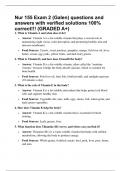Nur 155 Exam 2 (Galen) questions and
answers with verified solutions 100%
correct!!! (GRADED A+)
1. What is Vitamin A and what does it do?
Answer: Vitamin A is a fat-soluble vitamin that plays a crucial role in
maintaining night vision, color perception, and promoting healthy skin and
mucous membranes.
Food Sources: Carrots, sweet potatoes, pumpkin, mango, fish liver oil, liver,
butter, cream, egg yolks, yellow fruits, and dark leafy greens.
2. What is Vitamin D, and how does it benefit the body?
Answer: Vitamin D is a fat-soluble vitamin, often called the "sunshine
vitamin," because it helps the body absorb calcium, which is essential for
bone health.
Food Sources: Fish liver oil, fatty fish, fortified milk, and sunlight exposure
(10 minutes a day).
3. What is the role of Vitamin E in the body?
Answer: Vitamin E is a fat-soluble antioxidant that helps protect red blood
cells and supports healthy skin.
Food Sources: Vegetable oils, nuts, milk, eggs, meats, fish, wheat germ, and
leafy green vegetables.
4. How does Vitamin K help the body?
Answer: Vitamin K is a fat-soluble vitamin that is essential for blood
clotting.
Food Sources: Leafy greens, liver.
5. What function does Thiamine (B1) serve, and where can you find it?
Answer: Thiamine (B1) is a water-soluble vitamin that helps with cellular
metabolism, allowing the body to produce energy.
Food Sources: Whole grains, fortified cereals, beef, pork, liver, peas, beans,
and nuts.
, 6. What does Riboflavin (B2) do for the body, and where can it be found?
Answer: Riboflavin (B2) is a water-soluble vitamin that supports
metabolism and acts as an antioxidant.
Food Sources: Milk, cheese, eggs, green vegetables, whole grains, organ
meats, poultry, and fish.
7. What is Niacin (B3) used for in the body, and what are its sources?
Answer: Niacin (B3) is a water-soluble vitamin involved in cellular
metabolism for energy production.
Food Sources: Fortified breads, cereals, chicken, tuna, liver, peanuts, dairy
products, and fish.
8. What role does Vitamin B6 (Pyridoxine) play, and where is it found?
Answer: Vitamin B6 is a water-soluble vitamin essential for protein
metabolism and red blood cell production.
Food Sources: Meats, poultry, fish, beans, nuts, seeds, dairy, fortified
cereals, and corn.
9. Why is Folate (Folic Acid) important, and where can it be obtained?
Answer: Folate is a water-soluble vitamin that aids in DNA synthesis and
neurotransmitter production; it’s especially important for preventing birth
defects during pregnancy.
Food Sources: Leafy greens, asparagus, liver, yeast, eggs, beans, fruits, and
fortified cereals.
10. What is the function of Vitamin B12 (Cyanocobalamin), and what are its
sources?
Answer: Vitamin B12 is a water-soluble vitamin involved in metabolic
reactions, especially in energy production.
Food Sources: Dairy products, meat, poultry, fish, liver, milk, cheese, and
eggs.
11. How does Vitamin C benefit the body, and what foods provide it?
Answer: Vitamin C is a water-soluble vitamin that aids in wound healing
and supports the immune system.




